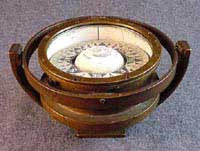 |
E.S. Ritchie & Sons 5
in. double card tell-tale compass, 1935
4.5 in. card calibrated in quarter
points and degrees. Bottom glass cracked, empty of liquid. Sold
by Ritchie to Negus 6/18/35.
This is a double card tell-tale compass that can be read
from above or below. A larger size of this model was commonly
used on whaling ships. It was mounted in front of the wheel in
a skylight over the Captain's cabin, so he could see the same
compass used by the helmsman, and the compass would be illuminated
at night by the cabin lights.
When I bought this, I thought it was a dry card compass,
but the catalog shown at right shows it to be a liquid compass.
This puzzled me, as liquid compasses require expansion chambers
usually in the bottom of the bowl under the card, and I didn't
see one. Howard Maglathlin at Viking Instruments Inc., S. Weymouth
Mass., explained the chamber is in the thick ring around the
bottom glass, which I had assumed was just weight to keep the
compass level.
Image courtesy Todd Harman, Md.
|
Ritchie's 1925 catalog description.
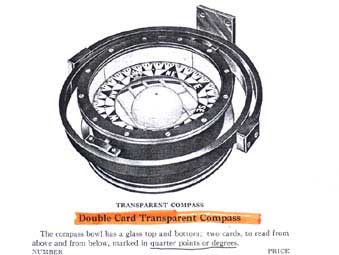
|
|
|
Kelvin, Bottomley & Baird Standard Dry Card Compass
Dry card compass designed by Sir William Thompson (Lord Kelvin) and made by Kelvin, Bottomley & Baird (successors to Kelvin & White in 1914) of Glasgow, Scotland. 10 inch diam. card, 11 inch diam. bowl. Designed with a very light weight card using a network of silk threads to connect the pivot to the aluminum ring and supporting the 8 needles.
Thompson patented this compass in 1877, and it soon became the standard steering compass for Royal Navy ships. By 1900, the dry card compass had been replaced by the liquid compass in the Royal Navy, so this compass, made after 1914, wouldn't have been used on a Navy ship.
Images courtesy Kahn Fine Antiques, Chatham Ma.
|
|
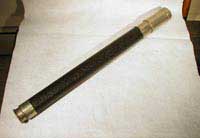 |
Ross Deck Officers telescope
Probably pre WWII. I've seen a WWII version, with the admiralty
Broad Arrow, and the signature is in block letters, not script.
Leather (poss. imitation) cover on main tube.
|
|
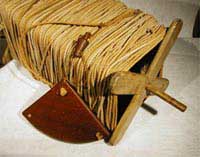 |
Chip Log, c. 1780 (according to dealer from whom I purchased it.) Complete with chip, line & reel, but no timer. I do have a modern reproduction brass log glass that runs 28 seconds to go with this. |
Approx. 50' between knots,
so would take a 28 second sand glass. |
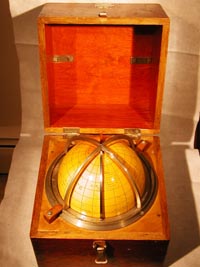 |
Russian Star globe, used for finding & plotting navigation stars. |
I have a rough idea how this was used, but would like to have a copy of the instructions from the similar globe made by Hughes. |
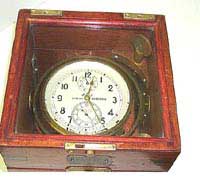 |
Russian chronometer "Kirova";
produced by the First Moscow Watch Factory. Probably 1970s, has
definitely been used on a ship. Unrestored, top lid removed. |
|
| |
Small gimballed liquid-filled
boat compass in homemade box with glass top. Unlabeled, but looks
like a Starr Compass. Card diameter approx. 1.8", brass
bowl approx. 2.75". Calibrated in half points. |
Belonged to my Uncle, Earl
Cahoon, who died in 1936. |
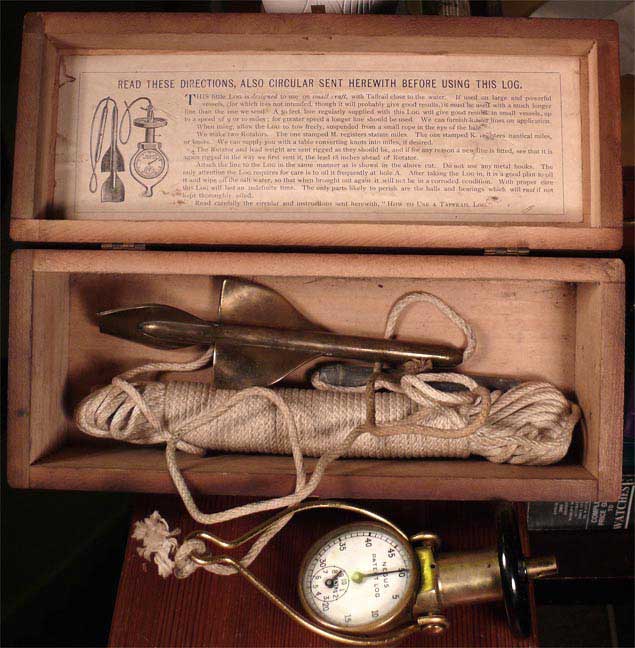 |
Negus Patent Log for small vessels. Box 10.5" by 4" by 3.75". Appears to have never been used, as line is perfectly coiled as it came from the maker, and paint & original finish seem intact. Register is 6.25" long, and spinner is 6.5" long.
I have an extra Negus register from the Schooner Virginia.
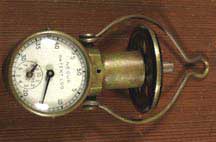
|
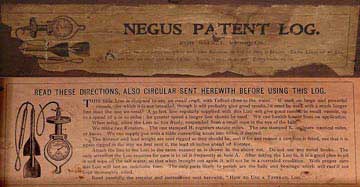 |

